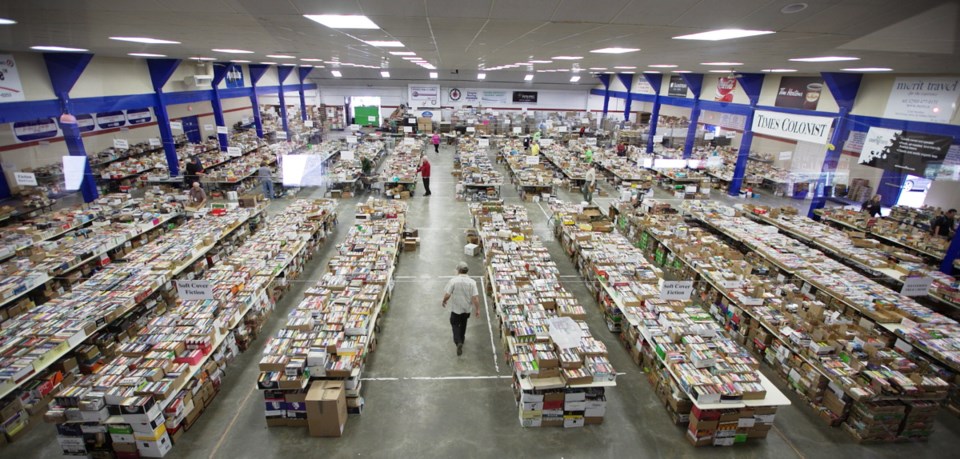 Nineteen things to ponder while lined up for the 19th annual Times Colonist Book Sale.
Nineteen things to ponder while lined up for the 19th annual Times Colonist Book Sale.
1. You really don’t need to line up. There’ll be plenty of books left on Sunday. Still, some can’t wait: the first people to arrive last year queued up at 1:50 a.m for the 9 a.m. opening.
2. The book prices — $1, $2, or $3 — haven’t risen since 2002. If the TC were in charge, the average Greater Victoria single-family home would still sell for $280,000, as was the case 14 years ago.
3. No rare-books cage this year. That might mean more gold nuggets being unearthed on the floor.
4. FOR THE FIRST TIME, THERE’S A LARGE-PRINT SECTION.
5. Among the odder finds among this year’s donations: A miniature edition of Dr. Jekyll and Mr. Hyde, marketed to kids in a mock cigarette pack complete with flip-top lid and silver foil wrapping. No, it won’t be sold in the children’s section.
6. Nor will the illustrated sex manual A Perfumed Garden, though it was initially mistaken for a children’s book.
7. Talk about donor’s remorse: At the drive-through collection, someone dropped off a purple Prince in Hawaii gift box (hardcover book, T-shirt, incense and other paraphernalia). Four days later, the singer died.
The donor got the box back this week, responding with a nice cash contribution to the sale.
8. Oddly enough, whoever inadvertently included a variety of women’s underwear in a box of books has not asked for the garments’ return. We also haven’t heard from those who have forgotten dope in their books over the years.
9. On Monday, May 2, teachers and representatives of non-profits may take away as many books as they like, for free, from 8 a.m. to 4:30 p.m.
10. After the teachers and non-profits have taken what they want, any remaining books are shipped to California by a company that buys them by the pound. The books are then sold online, donated to literacy groups and non-profits, or, as a last resort, recycled.
11. The sale led a nomadic existence before finding a home at the Victoria Curling Club in 2010. The first six sales were held in the then-empty top floor of the Times Colonist building. Next came the old Bay building, now the Hudson. Then it was the former Brick on Quadra, now a Fairway. The came the empty NOW building, now Jordan’s. The curling club is just the curling club.
12. In 2000, members of Canada’s Pacific Pride men’s under-23 rugby team pitched in at the book drop-off. At one point they stripped off their shirts and held a chin-up contest on the TC loading dock, prompting one of the women in the newsroom to ask: “Can I take one home, just to play with?” No, she was told, you may not.
13. HMCS Protecteur dropped off some of the books from the first sale when it visited Russia and China, where English-language books were hard to come by in 1998. Some of the books donated to the 1999 sale were sent straight to Watson Lake, Yukon, whose library had been destroyed by fire. In 2007, a shipment of books went to Hartley Bay in recognition of the tiny community’s response to the sinking of the Queen of the North.
14. One of the first donors in 1998 was The Q’s Ed Bain, who surrendered books his son had grown out of. “It’s really important for kids today because if you can’t read, you can’t write, and if you can’t write, you can’t fill out those unemployment forms,” he said.
15. Volunteer Renate Raudaschl calculated that the typical book-sorter walks nine kilometres and burns 1,000 calories a day during the lead-up to the sale. Please thank them while you’re shopping.
16. In 2005, Sen. Pat Carney found a signed copy of her memoir Trade Secrets at the book sale. It had been signed by someone else.
17. We once had an octogenarian shoplifter whose trench coat was so laden with books that he could barely move. We had to give him a little nudge to help him out the door.
18. Those planning the first sale in 1998 had no idea how many books would be donated. “We can store them in my office,” the editor suggested. No, his office wasn’t that big.
19. That sale brought in $20,800. Last year, it was $157,000.
Thanks to the TC’s readers, more than $2 million has been raised for literacy over the past 18 years. Good for you.



